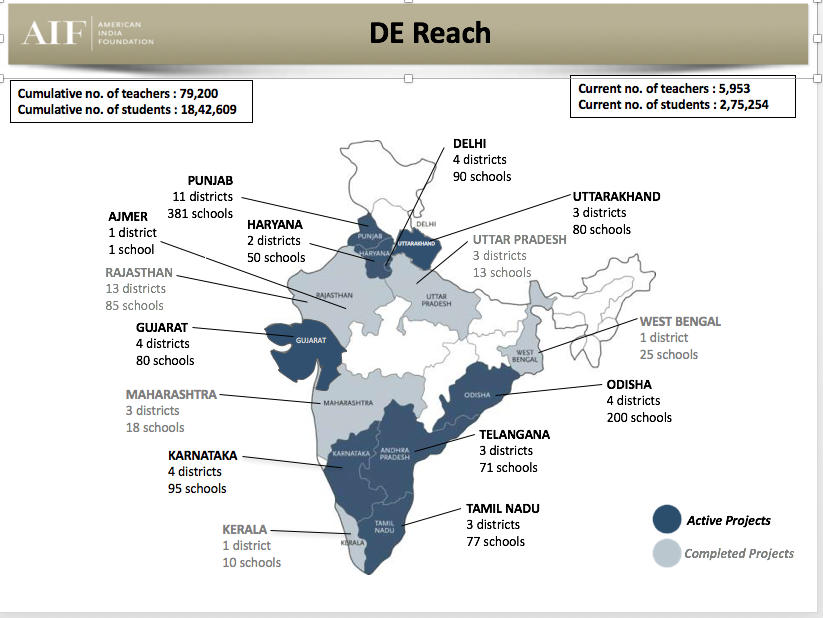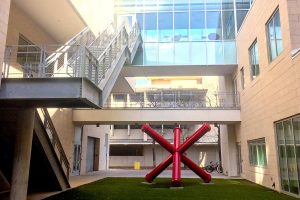It is fabulous to see that despite the many complex barriers that exist in STEM education reform relating to social justice, change is both possible and scalable! I hope this will provide food for thought to all educators working towards social justice in any part of the world. We can borrow from each other’s methods and strategies to serve our students!
Here is the second part of an email interview with Sundar Krishnan, Director of the Digital Equalizer Program, together with some sample testimonials from teachers and students who have participated in this program. Click here to read Part I of the conversation.
What is the rationale for working in the geographies you are in India?


Our rationale is tied into some specific program milestones in the history of DE, which can be summarized in two important phases:
Government Partnerships: 2005-2006
Perhaps the most significant strategic shift in the DE program was our decision to work more closely with state governments. The logic for this was very simple – if DE was to make a major impact on the children whose lives it wished to transform and with limited funds (but its limitless knowledge base), it had to work in government schools not only because most of these children attend such schools but also because the governments have the funds (and increasingly, the inclination) to support Computer Aided Learning (CAL) programs.
We piloted this approach with governments to “prove” that the DE approach, which has been successful in non-government schools, is equally relevant to government schools. This approach was still on a pilot mode of running 10-20 schools where the government paid for some of the costs (typically hardware and, over time, running costs) while the DE team provided training and support services. This approach was implemented in the states of Kerala, Andhra Pradesh, West Bengal, Orissa and Delhi.
In the state of Punjab, DE had played an unusual role. The state had designed and implemented its own programme of bringing computers to government schools and in the first phase had begun implementing this programme in 1,300 schools. AIF’s role was to provide quality and monitoring services as an independent third party and had deployed a team of over 50 people in the state led by a program manager based in the Education Ministry’s office in Chandigarh. What makes this unusual was that DE team was lending its knowledge and expertise to implement a non-DE program at the invitation of the Punjab state government. The expectation was that AIF’s DE experiences and learnings would be incorporated to make the government program more effective, while AIF could bring this experience to bear in large-scale programs that it implements with other state governments.
Launch of Large Scale Program: 2006-2008
By 2006, the DE program had a reached a point where it was clear that its way forward was a large scale model working in government schools. We leapfrogged to roll out this large scale program, which required a different team structure, capacity and mindset. Almost overnight, we grew from 100 schools and 10 Coordinators to 500 schools and 70 Coordinators.
Since this time, we have been partnering with governments across the country which either evinced interest or those with whom there was an opportunity from a donor for a preferred state in India. Today we are in 10 states and, as of this writing, operate actively in 1,125 schools.
Some sample DE Teacher and Student Testimonials:


The digital content that DE Program provides has captured the attention of students. I have been a Maths teachers since 1999. Earlier, the students faced difficulties in writing assessments. Below average students could not even answer basic and straighforward questions.
When DE program was introduced, with the DEWoT and FC method of teaching, I started to engage my students by showcasing videos and pictures relevant to the topic. For example, several students in my class had difficulty understand Practical Geometry. Videos showcasing angles, perpendiculars and how to draw them helped me engage the students better in it and also ensured I had time to move around and see the students actually draw the angles and bisectors. Gradually I saw improvement in their performance. Now, my students can read the content and also they have started to answer objective questions and some students can do word problems too. Videos seem to have captured their interest and made my work more easy and much more efficient.


I have been working with AIF methodology of DEWoT and FC for one year now and it has a great impact on students. The student engagement part is very useful because it makes the students concentrate and builds the interest on the topic. For topics like Crop Production and Management, the students of Chennai who have never seen an agriculture land etc. were interested in the topic thanks to exciting student engagement questions probing gently on the students’ prior knowledge and connecting the topic with it. It makes the students realize that they know somethings already and creates a positive environment of learning.


“As a teacher of Vejalpur Primary School, I am enrolled as a DE teacher in the Digital Equalizer program of AIF since 2014. I apply DEWoT or ‘Digital Equalizer Way of Teaching’ in classroom. This is a unique way of teaching which is based on four cornerstones, each having its own importance to make teaching process more effective.
Student engagement techniques help me to apply the the “known to unknown”, “concreate to abstract” concept. I use a lot of real life examples in classroom for this. Students are also encouraged to think and express their experience, and link it with the topics. Before DE program, I used to treat technology as a separate means of teaching. But this program has helped me to integrate technology in a more effective way. Through selective videos, images which are of high quality and digital content of edukit I can teach and explain hard topics. The most important part of the DE teaching method is group learning, activity, game based learning and peer group discussion which build confidence among students to learn in group, to learn interpersonal. HOT questions helps the students to think critically and creatively. I also learnt about reflecting on my teaching.”


I am a student of standard-8 in Vejalpur primary school. Digital Equalizer program has been running by AIF in our school for last two years. Our teachers use computers to teach the subjects to us under DE program. I like to study through computers more than my normal class. In the DE class, teachers tell us stories, ask questions, show videos and do activities in group. It strongly helps me to engage in classroom, learn topic and think creatively. Just as I see television and remember most of what I watch, I remember easily what I learn in DE class. During the group activities in the DE class I learn and understand topics with my friends. Sometimes our teachers give us questions to think at home to find solutions and come back to school with answers. An example of such a puzzle is “Tree is a living thing but whether dried parts of tree are living things”. We learn lot of new things from DE class.


I use live projects in the classroom which helps students to understand the concept and also connect it to real world scenario. It also ensures that knowledge is transmitted into application.


In my classroom reflection has helped to make students aware of their own thinking process and also it enables assessment of the “why” and “how” of the learning, and what needs to be done as a result. Framing different kind of reflective questions based on the topics which involves factual and higher order thinking questions ensures a check for understanding of the students.


Sundar comes from a humble middle class Tamil Brahmin family born and brought up in Delhi. He studied at Delhi University where he did M.Sc in Electronics, and thereafter obtained an MBA from the Faculty of Management Studies. Software and Information Communication Technology are in his DNA. Before AIF, he worked at the Media Lab Asia, a joint initiative of MIT and the Indian government’s Deptartment of IT, where he was managing ICT programs for the masses. He is happily married with two children. His wife is an Economist with a leading Public Sector Unit in Delhi. Their son is in grade 10 and their daughter is in grade 5.








Add comment